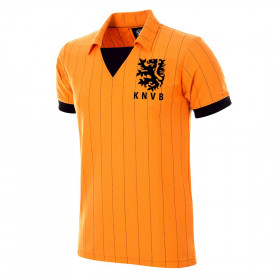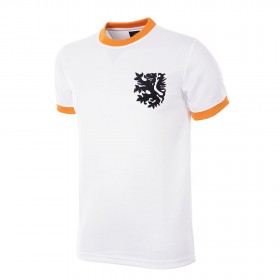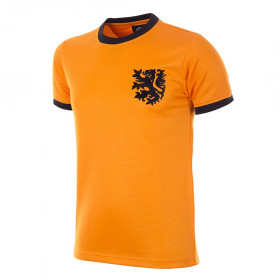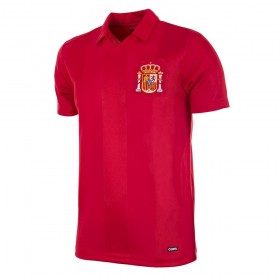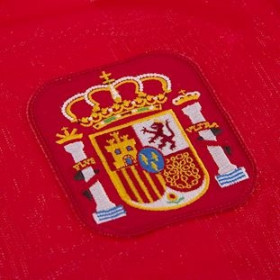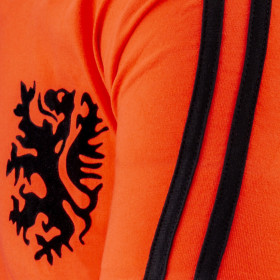Netherlands Retro Shirts

-
Holland Vintage shirt 1966
£55.39 -
Holland 1994 Retro Shirt
£55.39 -
Historical Jersey Spain 1984
£55.39
Our assortment of Holland Retro Shirts stands for the legendary moments in the history of the Holland national team. With our Retro Jerseys we inspire supporter of oranje with models like:
• The Holland Jersey of Cruyff: a popular model, which was worn during the World Cup 1974 in Germany. In this year the team from the Netherlands emerged as one of the big surprises in the World Cup and started a football progression, which surprised the world of football. Supervised by Coach Rinus Michels and with legendary Player like Cruyff, Neeskens, Krol or Resenbrink, the team wqas close to winning the World Cup. And indeed, like Cruyff said, it never happened before in history that the runner-up was more remembered than the actual champion. Only Holland managed to accomplish this uniquity.
• Holland Shirt of 1983, a phase of change for Oranje, when the glorious team of the seventies had to get reconstructed.
Even if Holland never managed to win a world cup, it deserves a special place in the history of football. The performance atr the world cup 1974, who was later named as Totalvooetbal, started an era, that is counted as one of the biggest revolution in football. Wear our oranje Football fashion with class.
History and jerseys of the Netherlands national football team
The first thing we need to do is to clarify the terminology. We will be using the term The Netherlands and Holland. Holland is one of the regions of the Netherlands but it has been used on many occasions, even by the Dutch authorities, to promote the country. For this exciting history of football in the Netherlands we will be using both names interchangeably.
The long journey of this selection began in 1889 under the Netherlands Association of Football and Athletics. The father of Dutch football was Pim Mulier who also founded the country's first football team; the Haarlemsch Football Club. Following the separation between athletics and football, the name changed to the Netherlands Football Association. In 1929, Queen Wilhelmina, to mark the 40th anniversary, gave this Association the name of Royal and was renamed the Royal Netherlands Football Association, the KNVB. Let us pause for a moment to reflect on the colors of this centenary team: the colors of the flag of the Netherlands are red, white and blue. How then is it possible that the Dutch football jersey is orange?
The answer is very simple, the color orange is the color of the Royal Dutch family: the House of Orange-Nassau. During the Spanish domination more than five centuries ago, revolts were organized in the north of the Netherlands to achieve independence and Prince William of Orange in the 16th century took a very active role, since then the Orange House became the Regents from the Netherlands. We are not going to go into more detail except to highlight that the history of nations and the history of the national teams are always connected.
Regarding the shield we can see the rampant lion of the royalty of the Netherlands with a sword and arrows representing the United Provinces.
In fact, if you find yourself on the King's Day, a National celebration in the Netherlands, you will think that the World Cup is being held and that the Netherlands has won the title.
If we think about the twists and turns of fate, even though the Netherlands team is one of the most respected teams in Europe and has also provided one of the most interesting football innovations in the history of this sport, the Total Football from the mythical Clockwork Orange team with Johan Cruyff, the World Cup title has never been won. Reviewing the record of the Dutch team we see that on three occasions they have reached the final and that in these same three occasions they have stood on the threshold of winning the championship. This is one of the thorns in a team that has deserved to include the desired world star above the badge on its shirt. His greatest triumph has been the victory in the 1988 European Championship.
The color orange has been the official color of this team since its beginnings. With very few exceptions, such as the 1934 World Cup, the players have worn orange kits. The shorts, however, have changed more often, going through white, orange, black or blue. As for the socks, the color orange will be used above all, but also the white or the blue color.
The away kit shirt has been mostly white but also in different shades of blue and black. In this second shirt the designers have allowed themselves more imaginative proposals and more innovative designs.
As for the brands of Dutch football we find Adidas in the 70s, Lotto in the 90s and Nike from 1996.

Holland National Team in 1905
History and football shirts of The Netherlands team - The 1930s
During the 1930s the Dutch football team participated in the 1920 Antwerp Olympic Games where they lost 3-0 to the host nation Belgium in the semi-finals. They won their first Bronze medal. The Dutch star player in that competition was Ber Groosjohan, a Rotterdam player who scored 5 goals.
For the 1930 World Cup, where all the Fifa teams were invited by the host country, Uruguay, the orange team did not attend the appointment due to the serious economic crisis of 1929.
From 1931 an important Dutch football personality, Karel Lotsy, took the reins with the purpose of professionalizing the national team.
The team qualified for the 1934 World Cup in Italy where they lost 2-3 in the round of 16 against Switzerland.
For this World Cup, the team will wear a blue shirt, with the shorts also in blue and the socks in light blue with an orange stripe. Except in its beginnings it will be the only occasion in which the team will not wear orange. If we look at a vintage photograph of the national team, the players wear the classic shirt of the period with polo collar, long sleeves and with laces instead of buttons and a large crest of the rampant lion of the Royal House of the Netherlands. If we look in more detail, some players wear buttons, others have a white lace, when the majority wear it in blue, which indicates that the making of the shirts was not unified. It's cool to think about it.
In the 1938 World Cup in France the Holland football team also managed to qualify. We highlight that the Dutch East Indies also played, today's Indonesia, which was a colony of the Netherlands in those years. In fact it was the first Asian team to participate in a World Cup. Both teams reached the round of 16 where they both lost; The Dutch East Indies team 6-0 against Hungary, and the Dutch team 3-0 against Czechoslovakia.
History and kits of the Holland Football Team - The 50s and 60s
Due to the outbreak of World War II, no World Cup was held. They were dark and wasteful years also in the football sport field, with few international matches, except for friendlies or matches between different nearby nations.
Starting in the early 1950s, an important milestone in the history of Dutch football took place; the Royal Netherlands Football Association, the KNVB, decides to professionalize Dutch football. This change was motivated by the exodus of Dutch soccer talent to other countries where players were paid and a drastic measure was also applied; those players who went abroad to play could not be part of the Netherlands National Team. We can say that 1954 is the date that marks the beginning of professional football in the Netherlands. Even so, the sports outcome would still be late in coming.
In 1950 the Brasilian nation set out to organize the Football World Cup. However, the Dutch team is devastated by the war and does not participate in the qualifying rounds nor in those of the 1954 World Cup. They will return to the competition to participate in the qualifying rounds for the 1958 World Cup but will not be able to qualify. The same will happen in the 1962 competition. This trend was perpetuated during the 1962, 1966 and 1970 World Cups.
However the shirt of those years is fantastic, with the round neck, short sleeves and the shield under a colored background Light Blue. Above you can see the Holland 1966 vintage shirt, more classic, simple but with its strong orange color hallmark of Dutch football.
History and jerseys of the Dutch Football Team - The 1970s
The question that arises if we analyze the historical course of this team is how could there be, after barren years, with hardly any participations in World Cups, an emergence of such good football in 70s ? Was it a coincidence? Was it due to a single personality, or was it the set of circumstances that came together ? What clubs were behind so much talent? What sports decisions were made?
The coach and former Ajax Amsterdam player Rinus Michels, the world star Johann Cruyff, Johan Neeskens another player chosen by the stars to represent the best of Dutch football, the innovative and impulsive game of the Amsterdam Ajax club, the pioneering team of Total Football and the Feyenord Rotterdam, coached by Ernst Happel, have the key to these questions. Since the late 1960s, both Clubs have achieved triumphs in the Dutch league but also in European competitions and pave the way for the Dutch national team in the 1970s.
Rinus Michels is appointed coach for the 1974 World Cup and explores and applies a new tactic; with an offensive game he proposes the permanent change of position of his players during the match, the invention works, it is called Totaalvoetbal, Total Football, a game where everyone attacks and everyone defends. This forerunner was named coach of the century by Fifa in 1999.
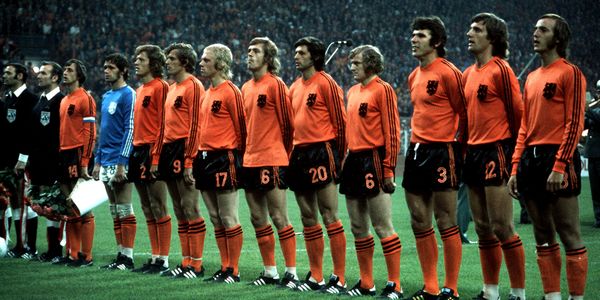
Holland National Team at 1974 World cup
The 1974 World Cup in Germany offered to the world this new way of playing football, leading the Dutch team to reach the final of the championship. To do this, they defeated Argentina 4-0 in the second phase, Brasil with Leao, Jarzinho, Roberto Rivelino 2-0 and East Germany 0-2.
Already in the final, playing the West Germans at home, it was impossible to beat the Teutonic team with players like Breitner and Muller. However Neeskens scored the first goal but the Netherlands team fell 2-1. Of course, they left with the title of runner-up and having amazed the whole world with a surprising football with accurate touches and total football.
In the 1978 World Cup in Argentina, the same fate would repeat itself. The Dutch, under the leadership of Ernst Happel would play the final match against the hosts. At the end of the match, tied at 1, Rob Resenbrink shot at the post in the 91st minute. In extra time the Argentines won the match 1-3. Johann Cruyff, the Flying Dutchman, as he was already called, did not participate in this competition for reasons that are still unclear, some say that they were ideological, against the Argentine dictatorship of Videla and others say because of differences with the Federation.

Holland National Team at 1978 World cup
At the above Retrofootball® Netherlands Retro Shirts section you can choose between different kits from those 70's; the astonishing Holland Vintage shirt WC 1974, worn by Cruyff with V-neck shirt and the mythical number 14 on the back, the Holland Vintage shirt WC 1978 both in orange and the super elegant white Away Shirt 1978 World Cup shirt.
History and jerseys of the Netherlands national football team - The 1980s
The 1980s were a long journey through the desert, in which the Dutch team failed to qualify for the final phase of the 1980 European Championship. They also failed to qualify for the World Cup 1982, the 1984 Euro, and for the 1986 World competition.
They tried to innovate with the shirts, which have a V polo neck and vertical thin black stripes, above you can access the Holland Vintage Shirt 1983/84 that Gullit and Koeman among others did worn.
However, we must highlight the advent of a whole new generation of great Dutch footballers; Gullit, Van Basten, Rijkaard, the two Koeman brothers, among others, a generation that finally paid off at 1988 European Championship.
At the 1988 Euro, the Dutch, led by historical coach Rinus Michels, qualified to play in the final against the feared Soviet Union of Valery Lobanovsky and the attackers, Belanov, Zavarov and Protasov. The first half ended in a 1-0 victory with a goal from Gullit. The second half with the miraculous goal by Van Basten, still considered one of the most surprising goals in the history of the European Championship. The Netherlands won the only title in its history in that 1988 competition, thus closing with this great victory a disastrous decade of renewal since the Cruyff generation and total football.

Holland National Team at 1988 European Championsip
The 1990s
In this decade, although the The Netherlands national football team managed to reach the final stages of all the championships, they did not achieve the expected results after the victory in the Euro 88. With their admired players, they started as great favorites in the competitions.
In the 1990 World Cup with the players of the previous European Championship, the Dutch team will fall in the round of 16 against the Germany of Matthaus and Klinsmann.
In the United States 1994 World Cup with Dennis Bergkamp, Overmars, Rijkaard, Wouters, de Boer and Koeman, among others, they fell in the quarterfinals, 2-3, in a spectacular match against the Brasilian champion team of Romario and Bebeto.
Four years later at the France 1998 World Cup the semifinals were played again against Ronaldo's Brasil where they were defeated on penalties, after 1-1 in regulation time and after having beaten the Argentinian team of of Bastistuta, Zanetti and Simeone by 2-1 in the quarterfinals. In the Ductch team, trained by Guus Hiddink, played Denis Bergkamp, Frank de Boer, Jaap Stam, Philip Cocu, Patrick Kluivert and Overmars.
The 2000s
In the 2000s decade and following years the Dutch team goes through different stages: the non-classification in 2002, the fall in the second round against the great Figo's Portuguese team, in 2006, until 2010 World Cup when they were finalists against Spain. They were on the verge of winning the final had it not been for goalkeeper Casillas's boot stop on Robben's shot. We see a very robust, defensive Dutch team with a football that was the antithesis of total football.
If we look at the journey over the decades of this team we wonder if it was a matter of bad luck that they have not yet won a World Cup. Yet they have given football history legendary players and tactics, revered by all connoisseurs. Can you ask for more?
To remember the great moments that the Netherlands team have given us, we suggest you to visit the above section of the Netherlands Retro Shirts. You will find the details and the history behind each shirt. Get a vintage shirt and feel the Holland's Total Football on your skin. Make a memorable entrance in the pub dressed in it, your friends will love it !
 Retrofootball
Retrofootball  Belgium
Belgium  France
France  Germany
Germany  Italy
Italy  Portugal
Portugal  Spain
Spain  Switzerland
Switzerland  United Kingdom
United Kingdom  other countries
other countries  Retrorugby
Retrorugby 




